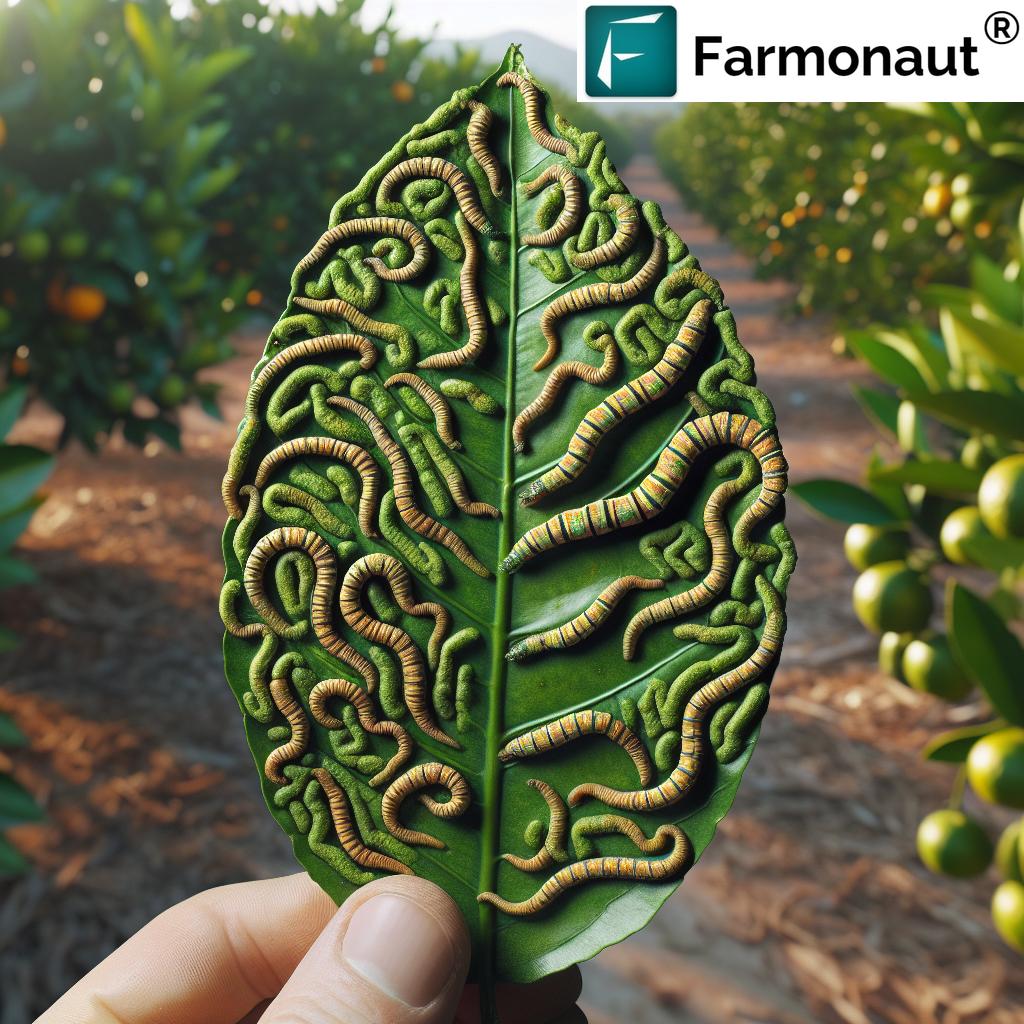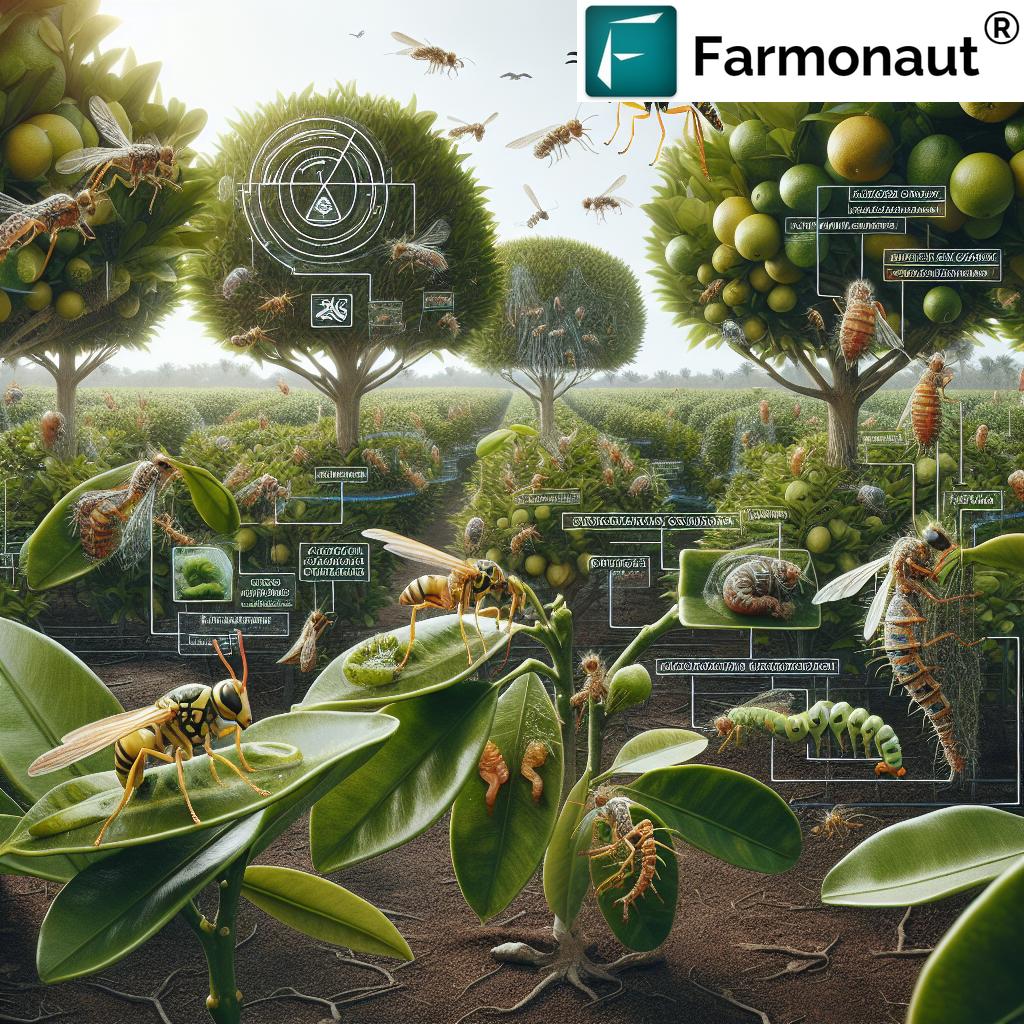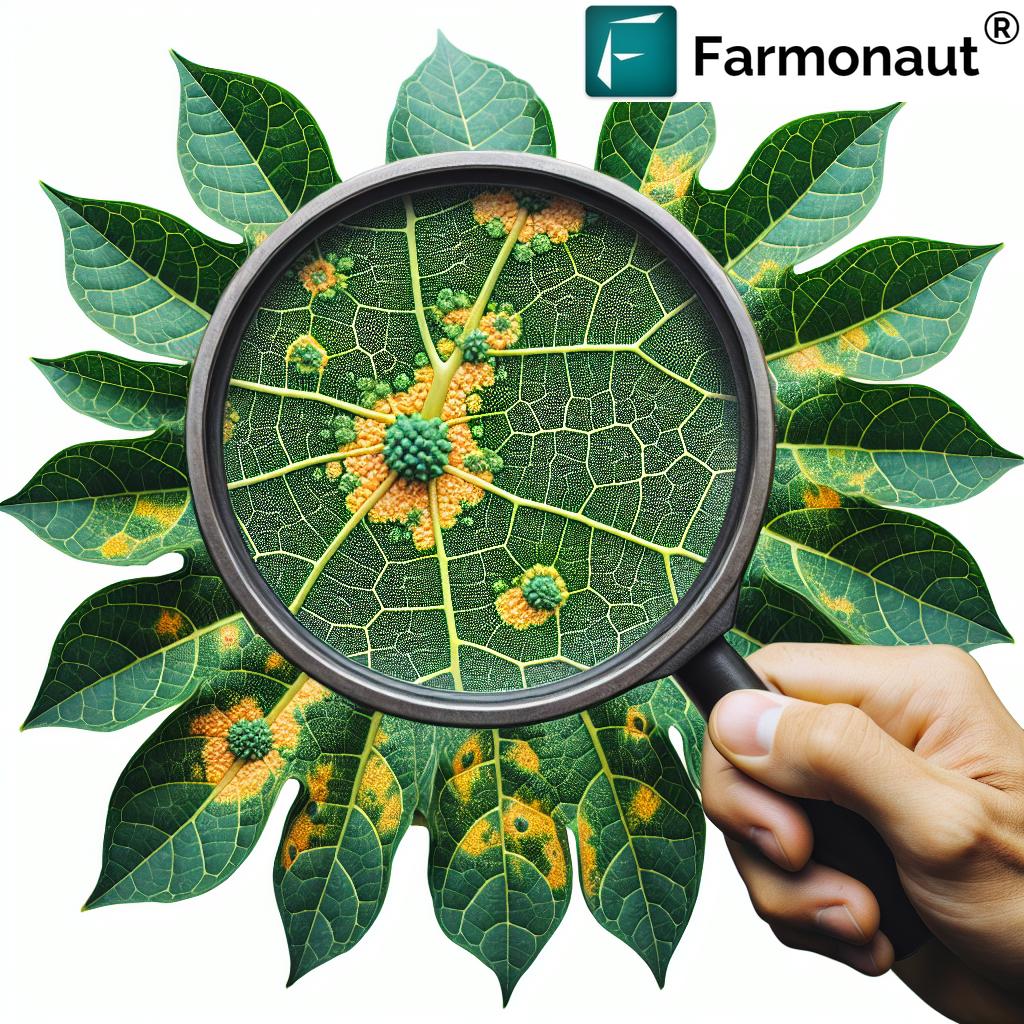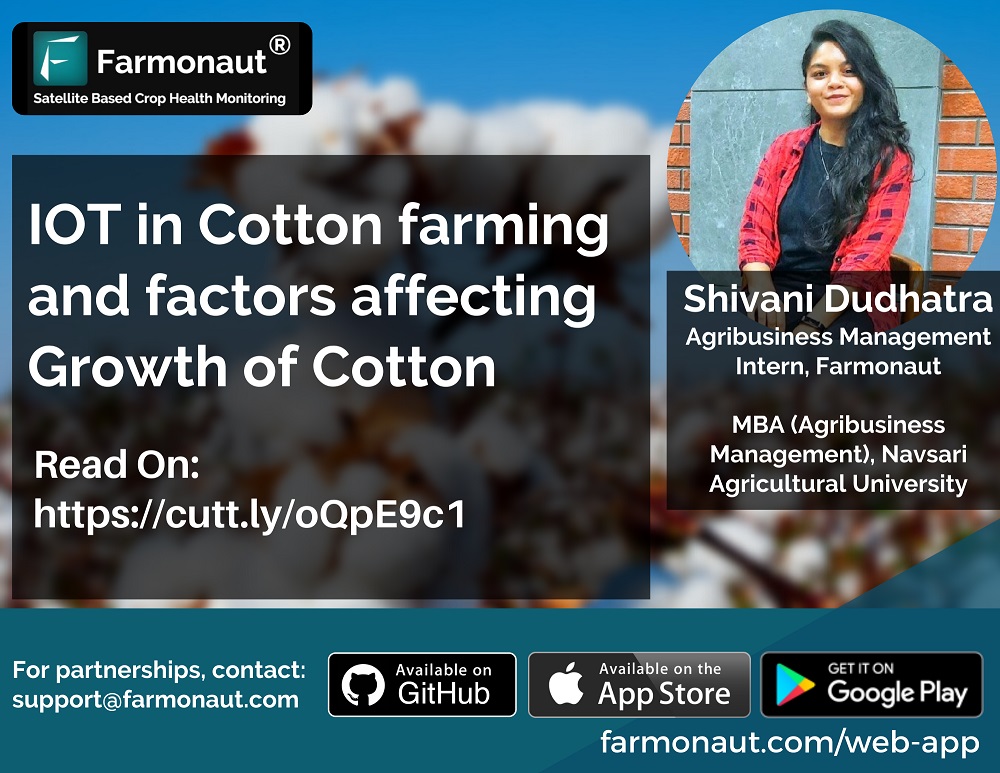- Introduction to Citrus Leafminer Control
- Biology & Life Cycle of Phyllocnistis citrella
- Why Citrus Leafminer is a Significant Pest?
- Treating Citrus Leafminer: 7 Shocking Control Hacks!
- 1. Smart Citrus Leafminer Monitoring & Early Detection
- 2. Cultural Practices: Timing, Fertilization, and Pruning
- 3. Leveraging Biological Control of Citrus Leafminer
- 4. Responsible Citrus Leafminer Chemical Treatments
- 5. Physical Barriers and Buffer Zones
- 6. Data-Driven Decision Making with Satellite-Based Crop Management
- 7. Integrated Pest Management for Citrus Leafminer Success
- Comparative Table: Sustainable Citrus Leafminer Control Methods
- Farmonaut Solutions for Sustainable Citrus Management
- Frequently Asked Questions (FAQ)
- Conclusion
Treating Citrus Leafminer: 7 Shocking Control Hacks!
Welcome to our comprehensive guide on citrus leafminer control, crafted for growers, agribusiness experts, and everyone passionate about sustainable citrus production. If you’re dealing with curled, distorted leaves or noticing shiny, serpentine trails on your young citrus foliage, you’re likely facing the infamous citrus leafminer (Phyllocnistis citrella). This pest silently targets thriving citrus crops worldwide, reducing growth and opening the door for devastating disease like canker.
In this post, we will unravel the citrus leafminer life cycle, explore why it’s so significant, and—most importantly—reveal 7 eye-opening control hacks using the latest integrated pest management (IPM) wisdom. We’ll spotlight how the smartest citrus producers are blending biological control strategies, sustainable monitoring, and precision technology to keep leafminer populations in check—without compromising the environment or crop quality.
Focus keyword: Citrus Leafminer Control
Biology and Life Cycle of Phyllocnistis citrella
Understanding the enemy is the first step in citrus leafminer management strategies. The biology and life cycle of the citrus leafminer unlock the keys to why controlling this pest is challenging and when interventions are most effective.
Meet the Citrus Leafminer Moth
- Adult leafminers are tiny, silvery-white moths, about 2mm long.
- Females lay single eggs on the underside of soft, expanding leaves—favored for their tender tissues.
- Larvae hatch and immediately tunnel into the leaf to begin their characteristic serpentine mining.
Life Cycle Key Stages
- Egg: Deposited singly, usually on newly flushing leaf surfaces.
- Larvae: Exhibit three instars, each producing winding mines as they feed between the upper and lower leaf surfaces.
- Pupation: Occurs at the edge of the mined leaf, usually within a rolled section.
- Adults: Emerge to mate and repeat the cycle, often producing multiple generations annually, especially during spring and summer.
The citrus leafminer life cycle (egg → larva → pupa → adult) advances rapidly, particularly where warm conditions drive citrus growth. This makes constant vigilance and a multifaceted approach essential.
Why Citrus Leafminer is a Significant Pest?
Citrus leafminer is more than just an aesthetic irritant—it represents a significant economic and ecological threat to citrus industries worldwide. Here’s why:
- Reduction in Photosynthetic Capacity: Larvae damage the leaves, creating mines that reduce the tree’s ability to harness sunlight for growth and fruit production.
- Leaf Distortion & Defoliation: Heavy infestations cause leaf curling, distortion, and, eventually, defoliation, stunting young trees and reducing overall growth.
- Disease Entry Points: The damage left behind provides perfect openings for pathogens like Xanthomonas axonopodis pv. citri, the agent of canker disease, worsening disease severity.
- Impact On Yields: Chronic infestations delay fruiting and reduce the quality and volume of citrus crops.
Given the scale and persistence of the problem, a well-rounded, knowledge-driven approach to control is not just best—it’s essential. Ready to discover the 7 shocking hacks for citrus leafminer control?
Treating Citrus Leafminer: 7 Shocking Control Hacks!
Let’s deep-dive into the most effective citrus leafminer control tactics—integrating cultural, biological, IPM, and technology-driven strategies for lasting results. The synergy between these approaches offers the best path to minimize larvae damage and protect the future of your citrus trees.
1. Smart Citrus Leafminer Monitoring & Early Detection
Timely monitoring and detection are our most potent weapons in citrus leafminer management strategies. Early action prevents rapid population growth and helps to minimize long-term damage.
- Pheromone Traps: Install specialized monitoring traps that attract adult male moths, helping us estimate populations and act before severe larvae damage occurs.
- Visual Inspections: Regularly examine young, expanding leaves for winding mines and subtle leaf distortion.
- Record-Keeping: Log the location, frequency, and severity of infestations to optimize intervention timing and track the effectiveness of control actions.
Incorporating smart satellite-based crop monitoring platforms (explained below) can further enhance detection accuracy and allow us to act faster, especially on large farms.
2. Cultural Practices: Timing, Fertilization, and Pruning
Our management journey starts with smart cultural control strategies. These proactive practices are both affordable and environmentally safe:
-
Fertilization Timing:
- Apply fertilizers strategically during winter to encourage flush growth in spring, when pest pressure is lower.
- Limiting fertilizer use in late summer and autumn reduces new soft growth—key feeding ground for larvae—thereby minimizing the risk of outbreaks.
-
Pruning:
- Routinely remove infested or damaged leaves (especially in late summer and autumn) to immediately reduce local populations and eliminate breeding sites.
- This step also enhances air circulation around foliage—discouraging adult moths from lingering.
- Sanitation: Dispose of pruned material away from your orchard to prevent re-infestation.
Pro tip: Combining cultural changes with strong carbon footprinting tools (link) from Farmonaut helps track improvements in field sustainability while keeping pest pressure down.
3. Leveraging Biological Control of Citrus Leafminer
Embracing the power of natural predators remains one of the most promising citrus leafminer control methods. Several beneficial insects keep populations manageable without harming the environment or beneficial species.
- Parasitic Wasps: Extensive use of Ageniaspis citricola, Cirrospilus quadristriatus, and Semielacher petiolatus—often introduced in several regions—parasitize and destroy leafminer larvae.
- Encourage Biodiversity: Avoiding broad-spectrum insecticides conserves these and other natural predators of citrus leafminer, strengthening orchard resilience.
- Monitor Effectiveness: Track natural enemy prevalence using visual observations and correlate with leafminer density; recalibrate treatments according to their impact.
By prioritizing biological control of citrus leafminer, we make our entire pest management approach safer, more holistic, and more effective for the long-term health of citrus trees.
4. Responsible Citrus Leafminer Chemical Treatments
When populations explode beyond controllable limits—particularly in young or newly established orchards—chemical treatments may be necessary. However, we recommend these only as a last resort in a broader IPM plan:
- Selective Insecticides: Use systemic, targeted compounds such as imidacloprid sparingly—apply during periods of peak egg-laying or early larval activity for maximum effect.
- Avoid Broad Spectrum Chemicals: These disrupt beneficial insect populations and may worsen future infestations by eliminating natural controls.
- Observe Pre-Harvest Intervals and Regulations: Always adhere to label instructions to avoid residue issues in consumer fruit.
Citrus leafminer chemical treatments should never be the backbone of your management system. Integrate with cultural, monitoring, and biological control for lasting effectiveness—maximizing protection and minimizing risk to non-target organisms.
5. Physical Barriers and Buffer Zones
Physical exclusion may sound old-school, but simple, cost-effective barriers can defend emerging flush growth and help delay wide-scale infestations:
- Protective Covers: Use fine mesh barriers on nursery plants and very young trees, shielding them from adult moth access during peak egg-laying season.
- Buffer Plantings: Introduce perimeter plant species less attractive to leafminers as a living defense wall.
- Windbreaks: Reduce moth migration and population build-up by interrupting direct airflow into orchards, making it harder for adults to locate vulnerable flushes.
6. Data-Driven Decision Making with Satellite-Based Crop Management
We live in the era of precision agriculture. Satellite monitoring platforms such as Farmonaut provide a bird’s-eye view of crop health, supporting the most advanced citrus leafminer control efforts by:
- Real-Time Crop Health Monitoring: Use AI-powered dashboards to track NDVI (vegetative health), soil moisture, and growth abnormalities across your orchard. Stress signals could correlate with hidden infestations before they escalate.
- Resource Optimization: Apply irrigation and fertilizers with scientific accuracy, ensuring balanced growth that reduces susceptibility to pests, while minimizing environmental impact (learn more here).
- Historical Data & Trend Analysis: Track year-on-year performance and refine intervention strategies using geo-referenced timelines on leafminer occurrences, flush cycles, and response patterns.
- Fleet and Resource Management: Sustainably coordinate mechanical, pruning, and fertilizer application activities from a single digital hub with Farmonaut’s fleet management modules.
Want to see Farmonaut’s full tech capabilities in action? Explore our platform here—accessible via Android, iOS, browser, and API.
7. Integrated Pest Management for Citrus Leafminer Success
No single strategy delivers long-term control. Integrated Pest Management for citrus leafminer unites all aforementioned practices to create a resilient defense grid:
- Monitor→Act→Review Loop: Use comprehensive monitoring (traps, visual surveys, satellite data) to make timely, strategic decisions.
- Threshold-Based Interventions: Take action based on population triggers—not routine scheduling—using a mix of cultural, biological, and (if required) chemical methods.
- Preserve Natural Ecosystem Services: Safeguard natural predators of citrus leafminer by minimizing disruptive insecticides and maintaining diverse habitat structures.
- Traceability & Transparency: Use Farmonaut’s blockchain-based traceability (link) to document pest management and provide transparent assurance to consumers of sustainably grown citrus.
- Link to Crop Loans and Insurance: Reliable yield records and pest control intervention histories, verified by satellite, simplify claims and optimize access to finance—explore options here.
Comparative Table: Sustainable Citrus Leafminer Control Methods
| Control Method | Estimated Effectiveness (% Population Reduction) |
Environmental Impact Level | Estimated Cost (per acre) | Application Frequency (times per season) |
|---|---|---|---|---|
| Cultural Practices (Fertilization, Pruning) | 30–40% | Low | $20–$40 | 2–4 |
| Biological Control (Parasitic Wasps) | 50–70% | Low | $50–$70 | 1–2 (release/augmentation) + ongoing conservation |
| Chemical Treatments (Selective Insecticides) | 50–80% | Medium–High | $70–$150 | 1–2 (as needed) |
| Physical Barriers/Buffer Zones | 30–40% | Low | $40–$65 | 1 (initial setup) |
| Monitoring (Traps, Scouting) | Indirect (enables early intervention) | Low | $10–$25 | 6–10 (weekly/biweekly) |
| Integrated Pest Management (All Methods Combined) | 80–90% | Low–Medium | $120–$250 | Ongoing/season-long |
| Sat-Based Crop Health Monitoring & Resource Optimization | Uplifts all above; Indirect | Low | $10–$30/mo (platform fee) | Continuous |
Farmonaut Solutions for Sustainable Citrus Management
As we move toward sustainability, integrating cutting-edge digital tools with established IPM and biological control creates a smarter path for every citrus operation. Here’s how Farmonaut makes this possible:
- Satellite-Based Crop Monitoring: Instantly assess crop health, flagging potential infestations and water/fertilizer stress before visible symptoms appear. Boosts actionable leafminer control.
- AI-Powered Jeevn Advisory System: Personalized, field-level pest and nutrient management guidance for citrus trees, optimizing yield while limiting resource input and environmental impact.
- Blockchain-Based Traceability: Assure buyers and regulators your citrus crops are sustainably managed and safe from unaudited chemical residues. Explore Traceability Solution
- Farming App Suite: Instantly access via web, Android, or iOS.
- API Access: Seamlessly integrate satellite imagery, weather, and pest advisory into your own platforms with our API. Deep-dive integration and technical documentation? See our Developer Docs.
- Carbon Footprinting: Evaluate, reduce, and document your orchard’s environmental impact—enabling true sustainability. Discover Carbon Footprinting
- Fleet Management: Orchestrate machinery usage, optimize logistics, and reduce operational costs with advanced fleet management.
- Large-Scale & Multi-Orchard Management: Manage multiple farms or vast citrus landscapes efficiently using Farmonaut’s Agro Admin Platform.
Frequently Asked Questions (FAQ)
1. What is the citrus leafminer and why is it significant?
The citrus leafminer (Phyllocnistis citrella) is a small moth whose larvae mine young citrus leaves. It is significant for citrus growers worldwide, not only reducing photosynthesis and stunting tree growth, but also increasing vulnerability to plant diseases like canker caused by Xanthomonas axonopodis pv. citri.
2. How do I identify citrus leafminer infestations?
Look for winding, silvery mines on newly emerged leaves. These are often accompanied by leaf curling and distortion. Monitoring with pheromone traps can also help detect adult populations early, before visible symptoms develop.
3. What are the safest methods for citrus leafminer control?
An integrated approach is safest: use biological control (parasitic wasps), adjust fertilization and pruning (cultural control), and only apply selective chemical treatments when absolutely necessary. Remember to prioritize sustainable, eco-friendly practices.
4. How does farm management technology like Farmonaut help control?
Farmonaut’s satellite monitoring provides real-time data on crop health and alerts users to early stress or pest patterns. Combined with AI-driven advisories, this allows us to monitor, act, and refine pest management with higher efficiency and lower environmental impact.
5. How does IPM differ from traditional pest control?
Integrated Pest Management (IPM) combines monitoring, biological, cultural, and (when needed) chemical controls—delivering better, more durable results than relying on chemicals alone. It is the gold standard for citrus leafminer management strategies.
6. Are citrus leafminer infestations harmful to mature trees?
Mature trees can usually withstand some larvae damage with minimal long-term effect, but young trees and nursery stock are much more vulnerable. Severe, repeated infestations can slow growth and reduce yield potential at any age.
Conclusion: Citrus Leafminer – Take Control Sustainably!
We’ve dissected every aspect of the citrus leafminer challenge—from the biology and dark reality of larvae damage to a holistic suite of citrus leafminer management strategies. The answer isn’t more chemicals; it’s careful observation, strategic action, and supporting natural predators—all amplified by smart digital tools like Farmonaut’s platform. By embracing these integrated, eco-friendly methods, we defend our trees, boost citrus yields, and protect the planet for future generations.
Ready to monitor and manage your fields smarter? Open your Farmonaut app today or discover full feature details on our Agro Admin product page. For custom integrations and advanced API access, please visit: Farmonaut API.
Let’s grow, monitor, and protect our citrus together—sustainably!

















